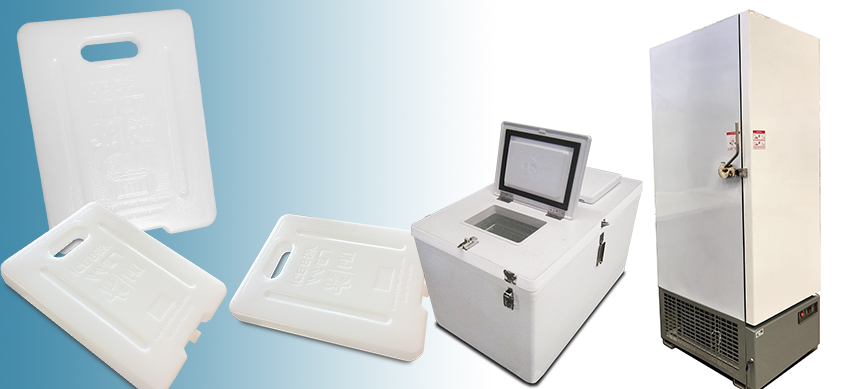When we’re talking about PCM, there are so many sets of different concepts to mention. Actually, Phase Change Materials (PCM) brings an advanced thermal protection when transporting a kind of temperature-sensitive products. When PCMs has been melt and frozen, or change phases of matter between solid and liquid, they will maintain a constant temperature which is equivalent to their melting/freezing point.
The best way to demonstrate this effect is to think about it in terms of water, which is also used as a PCM. Of course water’s solid/liquid phase change point is 0°C. In order to keep a cold product in warmer weather, water must be cooled below its phase change temperature until it freezes and becomes ice. When the ice is placed in a package around the temperature-sensitive product, it forms a 0°C thermal barrier between the product and the outside environment’s temperature. The ice begins absorbing the surrounding heat and starts to melt. As the ice melts, it maintains that 0°C temperature barrier and continues to absorb the heat until it has exhausted its thermal capacity and completely liquefies. At this point, the temperature of the water begins to rise above 0°C rapidly until it reaches equilibrium with the ambient temperature.
A Phase Change Materials will work the same way to protect the product, but the temperature that it maintains is its own innate melting/freezing point, which will be different than water. For example, a PCM with a phase change point of 5°C is more appropriate for a 2-8°C application because it will maintain a temperature within the application range, whereas water will not at 0°C.
One of the most important things to keep in mind when utilizing a phase change material is its optimal starting temperature condition. Certain applications might require you to condition your PCM as a solid prior to shipment, while others will require you to condition as a liquid. This is dependent on whether heat is overall being gained or lost by the package during shipment. (The PKI’s team can guide you to the proper conditioning method for your application.)
Whether a product needs to be kept frozen, refrigerated or at room temperature, PKI offers a variety of Phase Change Materials that are safe and effective thermal management solutions for products shipped within the cold chain.
Key Characteristics of PCMs:
- Latent Heat Storage: When a PCM changes from solid to liquid (melting) or liquid to solid (freezing), it absorbs or releases heat without a change in temperature. This heat is called latent heat, and it can be stored and released as needed.
- Phase Change: The PCM typically undergoes a phase change at a specific temperature range. For example, a PCM might melt at 25°C and freeze at 20°C. The material can then absorb heat when it melts (solid to liquid) and release it when it solidifies (liquid to solid).
- Thermal Energy Storage: PCMs are highly effective for storing thermal energy because they can absorb and store large amounts of heat energy during their phase change process. This makes them valuable for improving the efficiency of heating and cooling systems.
Types of PCMs:
Applications of PCMs:
- Organic PCMs: These include materials like paraffin waxes and fatty acids. They are generally non-toxic, chemically stable, and have a wide range of melting points, making them adaptable for different applications.
- Inorganic PCMs: Examples include salt hydrates and metallic alloys. These materials often have a higher latent heat capacity but can be prone to corrosion or instability over time.
- Eutectic PCMs: These are mixtures of different materials that have a lower melting point than any of the individual components, often resulting in better thermal properties and efficiency.
- Building Temperature Regulation: PCMs are used in construction materials (such as PCM-enhanced drywall or insulation) to help buildings maintain a stable indoor temperature by absorbing excess heat during the day and releasing it at night.
- Thermal Energy Storage Systems: PCMs are used in solar thermal systems, where they can store heat collected during the day for use at night or during cloudy weather.
- Cooling and Heating Systems: PCMs are used in personal cooling garments, refrigeration systems, and in the electronics industry to manage heat dissipation.
- Transportation: In vehicles, PCMs help in temperature regulation, such as in battery cooling or temperature-sensitive goods transportation.
- Electronics: To prevent overheating, PCMs can be embedded in electronic devices and batteries to manage their internal temperatures.
Benefits of PCMs:
- Energy Efficiency: PCMs improve energy efficiency by storing excess heat and releasing it when needed.
- Temperature Stability: They help to maintain a consistent temperature, reducing the need for active heating or cooling systems.
- Sustainability: By reducing the demand for energy, PCMs contribute to greener, more sustainable energy solutions.
In summary, Phase Change Materials are valuable for applications requiring efficient thermal management, helping save energy and improve comfort in various sectors.
